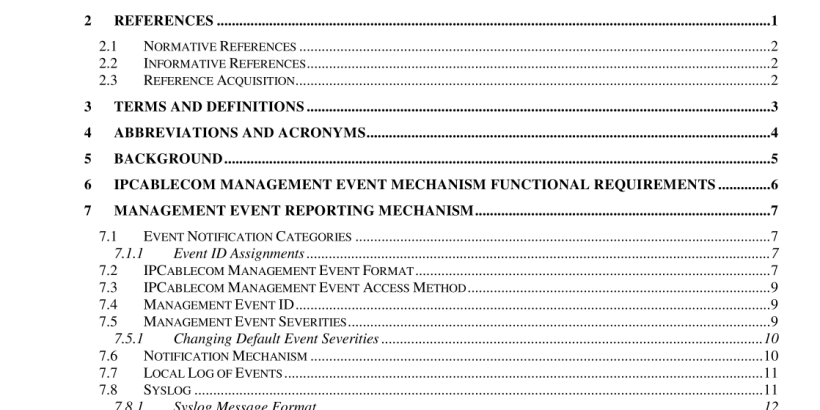ANSI SCTE 165-16-2016 pdf download.Management Event Mechanism
1.1 Purpose
This standard defines the Management Event Mechanism that IPCablecom elements can use to report asynchronous events that indicate malfunction situations and notification about important non-fault situation. Events are defined in this standard as conditions requiring the reporting of information to management systems and/or local log. A goal of IPCablecom is to maintain consistency with the DOCSIS® event reporting mechanism [6].
1.2 Scope
This standard is one of two documents that together define a framework for reporting Management Events in the IPCablecom architecture. This document defines the general event reporting mechanism and framework. The mechanism consists of a set of protocols and interfaces that can be used by individual elements and components in the IPCablecom architecture. This document defines how the SNMPv3 transport protocol, SYSLOG, local log, and the IPCablecom Management Event MIB are used to carry management event information to an event management system. This management event mechanism is further defined and supported by the Management Event Mechanism MIB as specified in [1], and [13] if the latter is implemented by the MTA. Consequently, each reference to the Management Event MIB in this document will correspond to the MIB as defined either in [1], or alternatively, in [1] and [13].
The legal/regulatory classification of IP-based voice communications provided over cable networks and otherwise, and the legal/regulatory obligations, if any, borne by providers of such voice communications, are not yet fully defined by appropriate legal and regulatory authorities. Nothing in this specification is addressed to, or intended to affect, those issues. In particular, while this document uses standard terms such as “call,” “call signaling,” “telephony,” etc., it will be evident from this document that while an IPCablecom network performs activities analogous to these PSTN functions, the manner by which it does so differs considerably from the manner in which they are performed in the PSTN by telecommunications carriers. These differences may be significant for legal/regulatory purposes.
2 REFERENCES
The following documents contain provisions which, through reference in this text, constitute provisions of this standard. At the time of Subcommittee approval, the editions indicated were valid. All documents are subject to revision, and while parties to agreement based on this standard are encouraged to investigate the possibility of applying the most recent editions of the documents listed below, they are reminded that newer editions of those documents might not be compatible with the referenced version.
2.1 Normative References
In order to claim compliance with this standard, it is necessary to conform to the following standards and other works as indicated, in addition to the other requirements of this standard. Intellectual property rights may be required to implement these references.
[1] SCTE 165-15 2016, IPCablecom 1.5 Part 15: Management Event MIB Specification.
[2] SCTE 165-09 2016, IPCablecom 1.5 Part 9: Event Messages.
[3] SCTE 165-19 2016, IPCablecom 1.5 Part 19: CMS Subscriber Provisioning Specification.
[4] SCTE 165-07 2016, IPCablecom 1.5 Part 7: MTA MIB.
[5] SCTE 165-14 2016, IPCablecom 1.5 Part 14: Embedded MTA Analog Interface and Powering.
[6] ANSI/SCTE 23-03 2012, DOCSIS 1.1 Part 3: Operations Support System Interface
[7] IETF RFC 3413/STD0062, Simple Network Management Protocol (SNMP) Applications, December 2002.
[8] IETF RFC 3164, The BSD Syslog Protocol, August 2001.
2.2 Informative References
The following documents may provide valuable information to the reader but are not required when complying with this standard.
[9] ANSI/SCTE 165-1 2016, IPCablecom 1.5 Part 1: Architecture Framework Technical Report.
[10] Network Maintenance: Alarm and Control for Network Elements, Bellcore GR-474.
[11] ITU-T Recommendation M.3100, Generic Network Information Model, 1995.
[12] ITU-T Recommendation X.733, Open Systems Interconnection – Systems management: Alarm reporting function, 1992.
[13] IETF RFC5428, Management Event Management Information Base (MIB) for PacketCable- and IPCablecom-Compliant Devices, April 2009.
[14] IETF RFC5234, Augmented BNF for Syntax Specifications: ABNF, January 2008.
[15] IETF RFC2131, Dynamic Host Configuration Protocol, March 1997.ANSI SCTE 165-16-2016 pdf download
